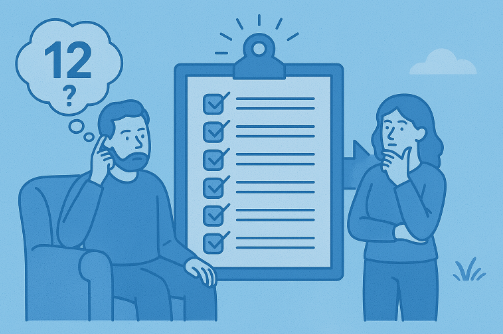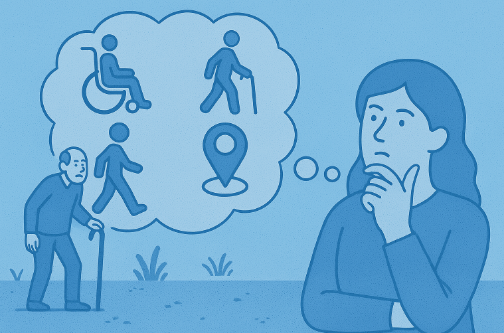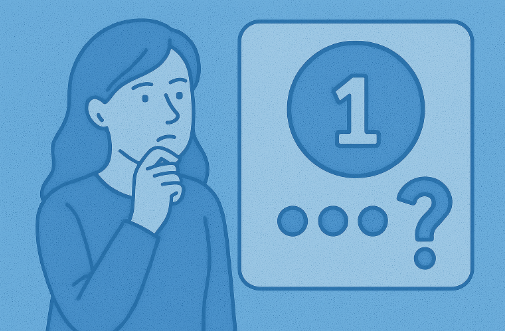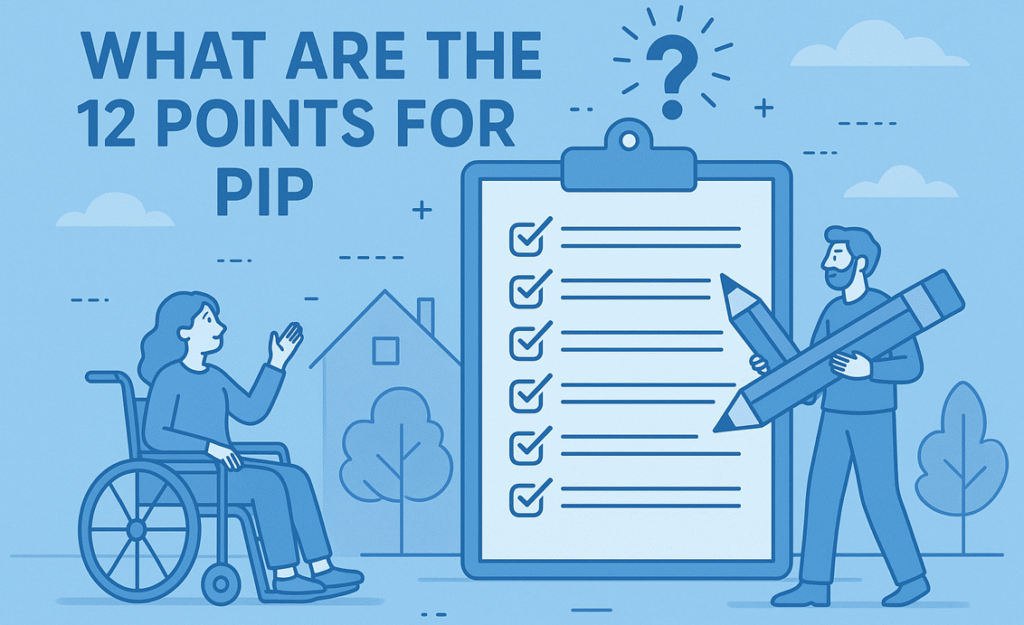What Are the 12 Points for PIP? Your Friendly UK Guide to Qualifying and Winning Your Claim
If you’ve ever tried to claim Personal Independence Payment (PIP), you’ll know it’s not always straightforward. One of the most common questions is: “What are the 12 points for PIP?”
Here’s the short answer: scoring 12 points in either Daily Living or Mobility can unlock the enhanced rate of PIP. But there’s a lot more to it — and in this post, I’ll walk you through exactly what those points mean, how you can score them, and how to avoid the common pitfalls that leave people short.
-
12 points in either Daily Living or Mobility = Enhanced rate PIP.
-
Points come from difficulties with everyday tasks (e.g., cooking, dressing, moving around).
-
Assessed using descriptors that award 0–12 points per activity.
-
The “reliably” rule applies: tasks must be done safely, repeatedly, in reasonable time, and to an acceptable standard.
-
Daily Living has 10 activities, Mobility has 2 activities.
-
Include supporting evidence from medical professionals, carers, or relatives.
-
Focus on your worst days — not just occasional good days.
What Does “12 Points for PIP” Actually Mean?

In plain terms, 12 points is the magic number for the enhanced rate of either part of PIP:
-
Daily Living Component
-
Standard rate: 8–11 points
-
Enhanced rate: 12 or more points
-
-
Mobility Component
-
Standard rate: 8–11 points
-
Enhanced rate: 12 or more points
-
These points aren’t random — they’re based on how your condition affects specific everyday tasks.
How Does the PIP Points System Work?
PIP is assessed across:
-
10 daily living activities (things like preparing food, washing, managing medication)
-
2 mobility activities (planning/following journeys and moving around)
Each activity has descriptors that describe different levels of difficulty — the more help you need, the higher your points.
What Are the Daily Living Activities That Score Points?
Here’s a quick list:
-
Preparing and cooking food
-
Eating and drinking
-
Managing treatments or medication
-
Washing and bathing
-
Dressing and undressing
-
Communicating verbally
-
Reading and understanding written information
-
Engaging with other people face-to-face
-
Managing money
What Are the Mobility Activities That Score Points?

There are just two:
-
Planning and following journeys – for example, if anxiety, cognitive issues, or sensory impairments stop you travelling alone.
- Moving around – Walking distances and your ability to do it safely, often, and within an acceptable amount of time are all included in this category.
What’s This “Reliably” Rule Everyone Talks About?
Four terms are used by the DWP to determine your ability to do an activity:
-
Safely – without hurting yourself or others.
-
To an acceptable standard – so it’s done properly.
-
Repeatedly – as often as needed.
-
In a reasonable time – roughly the same as someone without your condition.
If you can’t tick all four boxes, you should get points — but many people don’t explain this clearly enough in their application.
Why Scoring 12 Points for PIP Feels So Overwhelming
If you’re living with a disability or long-term health condition, the Personal Independance Payment form can feel like a test you’re set up to fail. You might be:
-
Frustrated — because you know your struggles are real but hard to put into words.
-
Worried — about losing financial independence.
-
Confused — by the jargon in DWP guidance.
The good news? You can prepare — and knowing the points system is step one.
What Is the New 4 Points Rule for PIP?
The new 4 points rule refers to changes in how certain descriptors are scored. In some cases, tasks that previously awarded higher points may now only give 4 points if you meet a lower threshold of difficulty. This means you might need to combine points from more activities to reach the standard (8 points) or enhanced (12 points) rates.
For example, if you can walk between 20 and 50 metres but need an aid, you might only score 4 points instead of a higher amount — making it essential to show other ways your condition impacts you.
What Is Question 9 on the PIP?
On the PIP2 “How your disability affects you” form, Question 9 asks about engaging with other people face-to-face. This is part of the daily living assessment and looks at your ability to interact with others:
-
Can you do it without support?
-
Do you need social support or prompting?
-
Does anxiety, cognitive impairment, or sensory issues make it difficult?
Answering this honestly is vital — if you need someone with you to feel safe or understood in social settings, that can score points towards your daily living total.
Detailed PIP Points Breakdown with Real-Life Examples
The Department of Work and Pension awards PIP points based on descriptors — statements that describe different levels of difficulty for each activity. Here’s how they work in everyday life.
Daily Living Component Descriptors
| Activity | Descriptor | Points | Everyday Example |
|---|---|---|---|
| Preparing food | Cannot prepare and cook a simple meal | 8 | You can’t chop vegetables or safely use a hob due to tremors or fatigue. |
| Eating and drinking | Needs assistance to eat | 2 | Someone must cut up food or remind you to eat due to memory issues. |
| Managing treatments | Needs supervision for medication | 1 | You need someone to watch you take medicine to prevent overdose or missed doses. |
| Washing and bathing | Needs assistance to wash hair or body | 3 | A carer helps you shower because you risk slipping. |
| Dressing and undressing | Needs help with clothes or fastenings | 2 | Arthritis makes buttons or zips painful to use. |
| Communicating verbally | Needs support to express or understand | 4 | Speech difficulties require a support worker in conversations. |
| Reading and understanding | Needs someone to read complex text | 2 | Visual impairment stops you reading letters from the GP. |
| Engaging with others | Needs social support to interact | 2 | Anxiety means you only speak in public with a trusted person present. |
| Managing money | Cannot budget complex decisions | 2 | You struggle to pay bills or calculate change without help. |
| Activity | Descriptor | Points | Everyday Example |
|---|---|---|---|
| Planning and following journeys | Cannot follow unfamiliar routes without help | 10 | Severe anxiety prevents you using public transport alone. |
| Moving around | Cannot walk more than 20 metres | 12 | You need a mobility aid to get from the car to the front door. |
Here’s a realistic scenario:
-
Preparing food – 8 points
-
Washing and bathing – 3 points
-
Managing money – 2 points
Total Daily Living Points: 13 → Enhanced rate achieved.
Pro Tip for Completing the PIP Form
Describe your worst days.
If your condition fluctuates, explain how often the bad days occur and what they look like. For example:
“On 4 days a week, I can’t prepare a meal without risk of injury because my hands shake so badly I drop knives.”
How Many Points Are There in 1 PIP?

There’s no single “1 PIP” score — PIP points come from different activities in the daily living and mobility components. Each activity can award between 0 and 12 points, depending on your level of difficulty. The points for each activity are then added up separately for daily living and mobility to see if you qualify for the standard or enhanced rates.
So “1 point” simply means you’ve met the lowest descriptor level for one specific activity.
How Can You Give Yourself the Best Chance of Scoring 12 Points?
Practical tips:
-
Keep a daily diary of your symptoms and struggles.
-
Use specific examples, like: “Yesterday I burned myself trying to cook without help.”
-
Include medical evidence from doctors, carers, or occupational therapists.
-
Don’t downplay bad days — describe them fully.
“Always explain how your condition affects you most of the time, not just on a rare good day.”
Common Myths About PIP Points (And the Truth)
-
Myth: “If I can do something once, I won’t get points.”
Truth: The Department of Work and Pension looks at what you can do on most days — if that’s less than 50%, it counts as not being able to do it. -
Myth: “It’s all about your diagnosis.”
Truth: It’s about impact on daily life, not just the medical label.
The Emotional Side of a PIP Application
It’s not just about money — it’s about independence, dignity, and feeling understood. For many people, scoring 12 points for PIP isn’t a “win” — it’s recognition of the challenges they face every day.
Conclusion: Why Understanding the 12 Points for PIP Is Power
Knowing what the 12 points for PIP mean — and how to evidence them — could be the difference between a rejected claim and the support you deserve. Break your experiences down into the activities, use the reliably rule, and don’t hold back on describing your toughest days.
FAQs About the 12 Points for PIP
Can I combine daily living and mobility points to reach 12?
No — each is assessed separately.
Do mental health conditions count towards PIP points?
Yes — if they affect your ability to do the listed activities.
Can I challenge a PIP decision?
Yes — first with a mandatory reconsideration, then by appeal if needed.
Can I get PIP with less than 12 points?
Yes — 8 points or more qualifies you for the standard rate.

I’m Joe Chris, co-author at ukbusinessmag.co.uk and a long-time enthusiast of all things business and finance. My background is in digital marketing and e-commerce, and I love diving into trends that impact the UK business landscape. Through my writing, I aim to make useful, real-world advice accessible to business owners.



